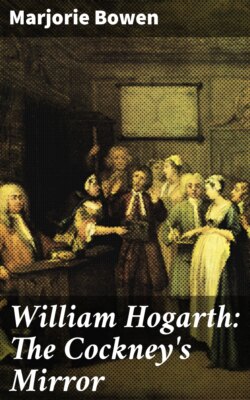Читать книгу William Hogarth: The Cockney's Mirror - Bowen Marjorie - Страница 17
* * *
ОглавлениеFor longer, more ambitious excursions, better made by water, were Kew and Richmond. The former was rendered very attractive by the royal gardens gradually laid out during many years by Sir William Chambers, the King's architect. Most of the marvels, however, with which he adorned the gardens were erected only towards the close of our period, 1758-1761.
Round this part of the river in Chiswick—Mortlake, Brentford, and Richmond—stood, amid the scenes of pastoral loveliness, the elegant houses of the wealthy and fastidious.
In Chiswick were two manors, a charity school, and the luxurious seats of several noblemen, the most splendid of which was the Palladian mansion of the Earl of Burlington, which possessed beautiful grounds and a costly collection of pictures.
Brentford, on the great thoroughfare to the West, was a busy market town, and many charming villas stood on the fine rising banks opposite Kew.
Richmond was reckoned 'the finest village in the British Dominions and the English Frascati'. The old palace of Sheen had gone, but on the site was a plain mansion built by the Duke of Ormond on land given him by William III; on the Duke's attainder this had escheated to the Crown. During the mid-eighteenth century this modest palace was beautified by additions of dairies, canals, temples, groves of trees, altars, pavilions and summerhouses in the artificial taste of the time.
There was a labyrinth, a Merlin's cave, a hermitage or Gothic ruin; all this was added under the direction of the energetic Queen of George II, Caroline of Anspach.
About the palace were cornfields, a heath of broom and furze, which sheltered hares and pheasants, pasture lands and forest walks.
Along the river front were mansions occupied by the Princes and Princesses, and round the spacious Green were elegant residences of 'persons of distinction,' among whom were Sir Charles Hedges, who had a magnificent villa boasting 'the longest and highest hedge of holly that ever was seen,' grottos, vistas, a decoy and 'a stone-house,' where the first English pineapple grew, and Mr. Heidegger, Master of the Ceremonies to George II and the ugliest man in the Kingdom.
Beyond the Duke of Cumberland's house was the Deer Park, and on the other side of the Green the village 'ran up a hill' to the celebrated view, 'the most rich, polished, luxuriant that any country can produce.' It was considered remarkable that the river should be tidal at Richmond, sixty miles from the sea, and it was declared that this was a greater distance than the tide was carried up any other river.
Sir Robert Walpole had another fine seat in the great Park, the finest, save Windsor, round London, and across the river was the bridge, not replaced by the admired structure in classic taste until the last quarter of the century.
Further on were other fine buildings, Ham House, belonging to the Earl of Dysart, and Marble Hill, belonging to the Earl of Buckingham.
Amid these 'delightful seats,' built in a classic style that contrasted piquantly with the delicate landscapes, were the modest but cosy retreats of the intellectuals, who, like Mr. Pope at Twickenham, lived in a rural retreat but yet under the shadow of the noble patron.
